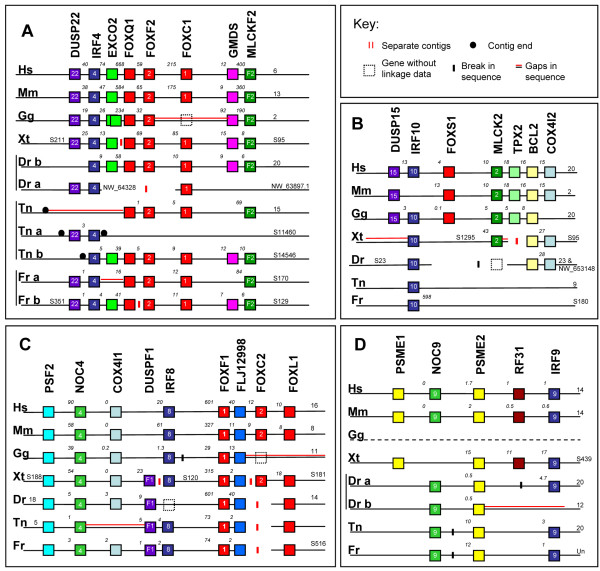XB-IMG-116888
Xenbase Image ID: 116888

|
Figure 2. Genomic organisation of human Fox cluster paralogons and putative orthologous counterparts. Genomic organisation of human (Hs) Fox cluster paralogons and the putative orthologous counterparts we have identified in Mus musculus (Mm), Xenopus tropicalis (Xt), Gallus gallus (Gg), Danio rerio (Dr), Tetraodon nigroviridis (Tn) and Fugu rubripes (Fr). Panels A, B, C and D depict orthologous genomic regions to the human regions on chromosomes 6, 20, 16 and 14 respectively, as shown in Figure 1. This is a schematic diagram and not to scale. Colour coding indicates orthologous genes inferred by molecular phylogenetics (see additional files). Numbers at the ends of each line indicate chromosome number, or, where this is not available, scaffold number, with the latter indicated by S or NW. Numbers above lines indicate approximate distance in Kb between genes. A parallel red line indicates gaps in the sequence, while breaks in the sequence are indicated by double vertical black lines at the site of inversions. Double vertical red lines indicate separate contigs that we placed on a line due to their gene content; this does not imply they have been shown to be physically linked. Dashed boxes represent presence of a gene but no linkage information. Black circles indicate scaffold ends. Image published in: Wotton KR and Shimeld SM (2006) Copyright © 2006 Wotton and Shimeld; licensee BioMed Central Ltd. Creative Commons Attribution license Larger Image Printer Friendly View |
